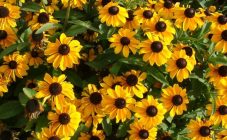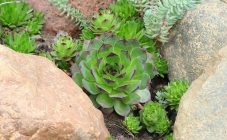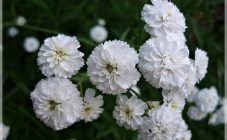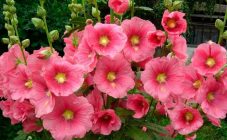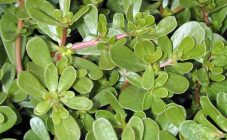Content:
Astrantia (from Latin Astrantia) is a rhizome perennial flower of the Umbrella family. The plant reaches a height of up to 1 meter. Leaves are straight, collected in a rosette, stems are slightly leafy, almost naked. Flowers are collected in original inflorescences, similar to stars. The color ranges from white to deep ruby. Astrantia planting and proper care of the plant in the open field allow you to achieve growth and long-term abundant flowering.
Care rules
For a flower like Astrantia, planting and care in the open field boils down to:
- regular watering,
- weeding from weeds,
- loosening the soil,
- introduction of organic and mineral fertilizers,
- upon detection of weeds and pests, timely treat the entire flowering bush with insecticidal (Aktellik, Aktara, Akarin, etc.) and fungicidal (Topaz, Skor, Colloidal sulfur, copper sulfate, etc.) agents.
Proper care promotes abundant flowering of large inflorescences that adorn the garden in early May. In some varieties, flowering is observed until September.
Due to its high frost resistance and drought resistance, Astrantia can be grown in regions such as Siberia, the Urals, and the northern regions of Russia.
Landing Astrantia in open ground
For better rooting and an early onset of flowering, the planting of Astrantia bushes is carried out in May - early June, so that in the fall, before the onset of the first frosts, a full-fledged root system can form that can withstand frosts.
It is better to plant flowers in an open sunny area without drafts. When planted in the shade, the plant stretches out, the stems become bare, the leaves turn pale, and the inflorescences become much smaller.
To achieve rapid growth and flowering, it is recommended to plant already formed and developing seedlings.
Saplings are planted according to the scheme 40 cm between bushes and 30 cm between rows. 1-2 years after planting according to this scheme, the plants form dense decorative thickets that adorn the garden with many flowers that look like stars.
The plant is unpretentious to the soil, but for high-quality growth and flowering, a fertile soil with sufficient moisture intake, loose without loam and stagnation is needed. If the soil is acidic or overly alkaline, then fertile black soil must be added to it before planting in order to improve the properties of the soil.
Before planting, a drainage layer of sand, a layer of organic fertilizers (household waste, rotted cow humus, tops and foliage of plants, etc.) must be added to the dug holes. Wells are well filled with water and rhizomes are planted. The soil at the planting site is tamped tightly and watered again.
For additional nutrition and moisture retention, the soil between the seedlings can be mulched with straw (hay, foliage, plant tops, agrofibre).
Leaving after disembarkation
After planting in open ground, you need to regularly care for the plants. The main care is reduced to the following activities:
- Regular and high-quality watering (in the hot period - 1-2 times a week, in the autumn period - 1 time in 10-15 days). For irrigation, it is necessary to use settled or rainwater.Additionally, you can water the bushes with decoctions from plants: chamomile, sage, nettle, dandelion, eggshell infusion.
- Weeding and weeding.
- Loosening the soil to enrich it with oxygen and improve the supply of fertilizers to the root flower system.
- Timely removal of faded peduncles, dried leaves, broken stems and flowers to stimulate the formation of new peduncles and enlargement of flowers. Correct pruning promotes the formation of new and larger flower stalks.
- Fertilization (phosphorus-potassium, nitrogen). Fertilizers are applied before budding.
- Carrying out preventive measures in the fight against pests and fungal diseases. Treatment of bushes with a solution of copper sulfate, fungicidal preparations.
- For the winter period, the shoots are completely cut off from the plant, from above it is mulched. In spring, the mulch layer is removed and shoots appear.
- Installation of trellises (supports). In case of intensive growth, it is recommended that plants be tied to stable supports to ensure stability in rainy and windy weather. Also, thanks to the supports, the flower “fence” will be taller, thicker and more attractive.
- Transplant after 5-7 years of growth in one place. Growing astrantia in one place for more than 8 years negatively affects growth, appearance and flowering. Peduncles become much smaller, the stems are elongated, the leaves turn pale and lose their attractiveness. Also, a transplant is recommended when the decorative effect of the bush is lost. In this case, the bush is cut and planted in a new place.
Diseases and pests
They note the high immunity of Astrantia to such flower diseases as powdery mildew, late blight, peronosporosis, fusarium, and rust.
Of the pests that infect the bushes of Astrantia, it is possible to distinguish naked slugs, aphids, spiderweb
tick.
If diseases are detected, it is recommended to completely spray the plant with a fungicide, paying special attention to the rosettes of leaves and stems. The most common and effective drugs are Skor, Topaz, colloidal sulfur, copper sulfate solution, etc.
If the disease manifests itself due to waterlogging of the soil, it is necessary to reduce watering and thoroughly loosen the soil to improve air circulation between the seedlings.
In the fight against pests, insecticidal preparations of a wide spectrum of action, such as Actellik, Aktara, Akarin, have an effective effect.
Experienced gardeners recommendations
Experienced gardeners recommend growing Astrantia with seedlings, dividing the bush (rhizomes). Vegetative propagation by dividing the rhizome is best carried out in the spring before the formation of peduncles. At the same time, the mother bush, from which the division was carried out, rejuvenates, which is manifested by its more lush and abundant flowering in the following year.
Hybrid varieties are best propagated by dividing the rhizome. By placing the cuttings in well-fertilized soil in open ground. From above, you can cover the planted cuttings with a plastic bottle for better rooting. The first shoots should appear a month after planting. The bottles are removed, and the soil between the plants is carefully loosened and mulched. The first flowering will appear in 2 years.
Astrantia looks most successful and impressive when planted with a composition of other perennial plants. Openwork leaves merge with lilies, gladioli, geraniums, irises, and cereals. A lush large flower sets off the beauty of coniferous shrubs.
Dense, dense plantings are an excellent decoration for curbs, garden paths and paths.
Due to the long-term preservation of freshness, cut flower stalks give special tenderness and beauty to the composition with other flowers.Dried flower stalks are used in the preparation of winter bouquets.
Astrantia is a perennial, unpretentious, beautiful flower. With proper care and proper planting, it pleases the owner with its flowering for many years. Due to the variety of colors of buds, you can choose colors for every taste and for any garden composition.




